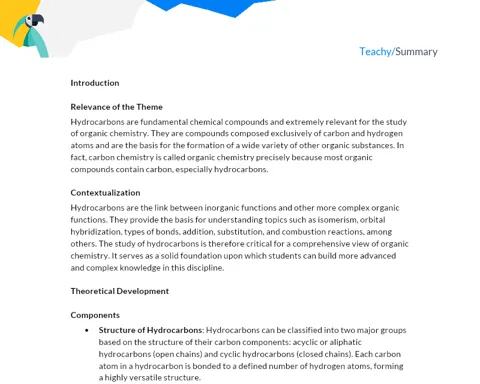Organic Functions: Nomenclature of Nitro Compounds | Socioemotional Summary
Objectives
1. Correctly name nitro compounds using IUPAC nomenclature.
2. Differentiate the nomenclature of nitro compounds from that of other organic compounds.
Contextualization
Did you know that nitro compounds, besides being essential components in explosives like TNT, also play crucial roles in the manufacture of medicines and dyes? Understanding the nomenclature of these compounds not only enriches your knowledge in Organic Chemistry but also opens doors to numerous practical applications in your daily life and future career. Let's explore together and discover the fascinating world of nitro compounds! 🎇🔬
Important Topics
Definition of Nitro Compounds
Nitro compounds are organic compounds that contain one or more nitro groups (-NO2) attached to a carbon atom. These compounds are known for their explosive properties and are used in the production of explosives, medicines, and dyes. The presence of the nitro group gives these compounds unique characteristics, making them highly reactive.
-
Nitro Functional Group (-NO2): This functional group is characterized by a double bond between the nitrogen and one of the oxygens, and a single bond between the nitrogen and the other oxygen. This structure gives the compounds high reactivity, especially in combustion reactions.
-
Industrial Uses: Nitro compounds are essential in the manufacturing of explosives such as TNT (trinitrotoluene). Additionally, they are used in the pharmaceutical industry for the production of medicines and in the dye industry.
-
Socio-emotional Importance: Understanding the reactivity of nitro compounds can help deal with frustration and stress in challenging situations, encouraging the pursuit of creative solutions.
Structure of Nitro Compounds
The basic structure of a nitro compound includes the nitro functional group (-NO2) attached to a carbon ring or to an aliphatic chain. The spatial configuration of this functional group directly influences the physical and chemical properties of the compound. For example, the presence of multiple nitro groups can increase the energy density of the compound, making it more explosive.
-
Nitro Group Bonding: The nitro group can be attached to different types of carbon structures, such as aromatic rings or aliphatic chains. This bonding defines the reactivity of the compound.
-
Physical Properties: Compounds with multiple nitro groups tend to have high melting and boiling points due to their highly polarized structure.
-
Socio-emotional Relevance: Analyzing the molecular structure of nitro compounds can develop problem-solving skills and critical analysis, essential for responsible decision-making.
IUPAC Nomenclature for Nitro Compounds
The IUPAC nomenclature for nitro compounds involves adding the prefix 'nitro-' to the name of the corresponding hydrocarbon. The main carbon atom chain is numbered so that the nitro group receives the lowest possible number. This nomenclature system allows for precise identification of compounds and facilitates scientific communication.
-
Numbering Rules: The main chain must be numbered so that the nitro group receives the lowest possible position. This is crucial for the correct identification of the compound.
-
Use of the Prefix 'Nitro-': The prefix 'nitro-' is added to the name of the hydrocarbon. For example, CH3NO2 is called 'nitromethane', and C3H7NO2 is '1-nitropropane'.
-
Comparison with Other Compounds: Nitro compounds have distinct nomenclature rules compared to alcohols and ketones. Understanding these differences is key to avoiding confusion.
-
Socio-emotional Impact: Mastery of IUPAC nomenclature promotes self-confidence and effective communication in scientific contexts and beyond.
Key Terms
-
Nitro Compounds: Organic compounds that contain one or more nitro groups (-NO2).
-
Nitro Functional Group (-NO2): Group characterized by a double bond between nitrogen and one oxygen, and a single bond with another oxygen.
-
IUPAC Nomenclature: Chemical nomenclature system developed by the International Union of Pure and Applied Chemistry to standardize the names of chemical compounds.
-
Trinitrotoluene (TNT): A potent and well-known explosive, composed of three nitro groups attached to a toluene ring.
To Reflect
-
How can understanding the properties of nitro compounds influence how you handle challenging situations in your academic and personal life?
-
In what ways can precision in IUPAC nomenclature improve your communication in group settings and work environments?
-
How can you apply knowledge about nitro compounds to promote responsible decision-making and problem-solving in your daily life?
Important Conclusions
-
Nitro compounds are organic compounds that contain one or more nitro groups (-NO2) attached to a carbon atom.
-
The IUPAC nomenclature for nitro compounds involves adding the prefix 'nitro-' to the name of the corresponding hydrocarbon, ensuring precise identification of the compounds.
-
Understanding the structure and nomenclature of nitro compounds is crucial not only for the study of Organic Chemistry but also for practical applications in various industries, such as pharmaceuticals and dyes.
-
Analyzing the properties of nitro compounds can develop essential socio-emotional skills, such as problem-solving, self-confidence, and effective communication.
Impact on Society
Currently, nitro compounds have a significant impact on society, especially in the pharmaceutical and dye industries. In the manufacture of medicines, these compounds are essential for developing drugs that treat various health conditions. Additionally, in the dye industry, nitro compounds are used to produce vibrant and long-lasting colors in fabrics, which directly affects people's daily lives, from clothing to consumer products. Understanding the chemistry of these compounds allows for innovation and improvement of industrial processes, resulting in better quality and safer products.
Emotionally, the ability to understand and apply the nomenclature of nitro compounds can increase students' confidence in their academic and scientific skills. This confidence is crucial for facing future challenges, both in academic and professional life. Knowing that acquired knowledge can be applied in real situations, such as in the production of life-saving medicines or in the creation of new materials, provides a sense of purpose and motivation to continue learning and exploring the world of organic chemistry.
Dealing with Emotions
To help deal with emotions during study, I propose an exercise using the RULER method. Start by recognizing how you feel when studying nitro compounds: are you frustrated, confused, or excited? Try to understand the causes of these emotions. For example, frustration may stem from the complexity of the topic. Name these emotions; identify them precisely. Then, express your feelings appropriately: talk with peers or teachers about your difficulties. Finally, regulate your emotions using breathing techniques, short breaks, or meditation. This exercise not only helps to better understand your emotions but also improves your ability to handle challenging situations in the future.
Study Tips
-
Make summaries using mind maps to visualize the links and structures of nitro compounds. This facilitates memorization and understanding of the content.
-
Practice IUPAC nomenclature by solving exercises from different sources. Constant practice is key to solidifying learning.
-
Participate in study groups: discussing the content with peers can clarify doubts, as well as develop communication and teamwork skills.



